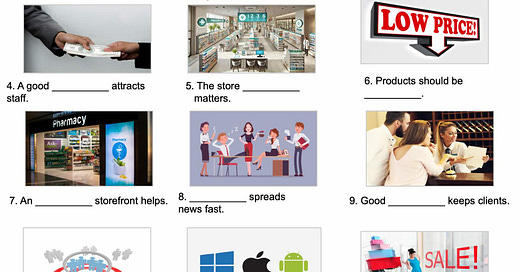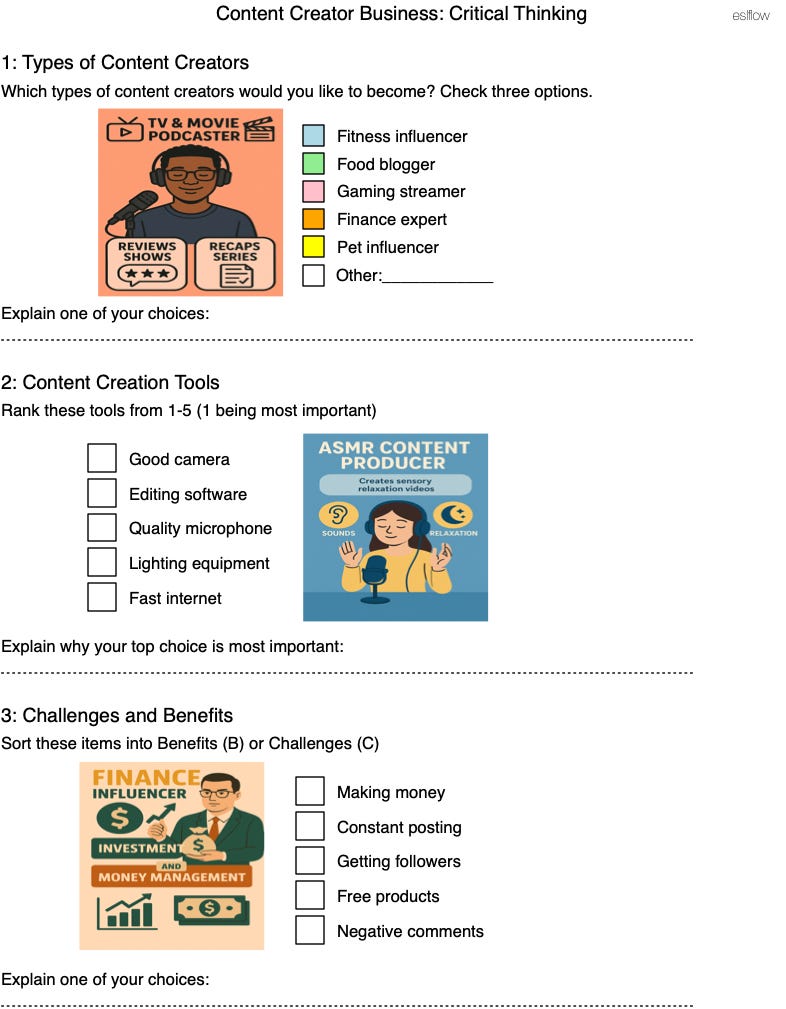Starting a Business in the 2020s: Converging Physical and Digital Worlds
Focusing on Types of Influencers and Content Creators
Today's post content:
8 new exercises relating to starting a business
3 listening exercises
2 videos
Paid subscribers have access to download the complete materials at the end of the post.
In today's interconnected economy, aspiring entrepreneurs are standing at a crossroads of possibility. One path leads to a storefront with an "attractive layout" and "welcoming staff." The other winds through the digital landscape where creators "build engaged communities" and "monetize content." These paths aren't separate journeys—they're converging routes on the same map. These exercises attempt to bridge traditional commerce with emerging digital professions, engaging students in conversations about modern hybrid business environments where physical and online presence often complement each other.
Influencers and Content Creators: Advantages and Disadvantages (with audio and video)
This activity explores the real-world advantages and challenges of eight different influencer business models that dominate social media platforms in 2025. By analyzing these contemporary content creation niches, students develop critical thinking skills while building vocabulary related to digital entrepreneurship, social media marketing, and online business models. The exercise connects directly to the economic realities students face as they consider career options in an increasingly creator-driven marketplace.
Visual Vocabulary
This visual vocabulary exercise connects students with the practical and traditional language of modern business ownership, from customer experience to strategic marketing.
Listening Exercise (complements Visual Vocabulary)
This listening exercise explores a realistic conversation between two aspiring business owners—Maya and Lucas—as they discuss the contrasting paths of online versus brick-and-mortar entrepreneurship in the 2020s.
Starting a Business: the Good and the Bad (with audio and video)
The gig economy and digital platforms have transformed how people launch businesses, making startup opportunities more accessible than ever before. This worksheet explores nine contemporary business models that have gained significant traction in the 2020s, from subscription services to virtual education. The exercise connects directly to real-world business trends, encouraging students to express opinions about career paths in this new economy.
Collocations: Mapping the Language of The New Economy
These language exercises navigate through both traditional business operations and digital creator economies. They act as a kind of language mapping that explores the linguistic DNA powering professional communication in 2025. Each collocation becomes another building block in a student's fluency architecture. By recognizing these natural word partnerships, students transform their business English from technically correct to intuitively authentic.
Critical Thinking
Starting a business today means choosing between a traditional physical store or an online presence—or finding ways to combine both approaches. These two exercises help students think critically about what makes businesses successful in both worlds. For offline businesses, they'll consider factors like location and customer service. For online content creators, they'll explore different creator types and the tools they need.




